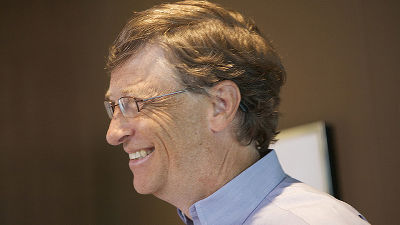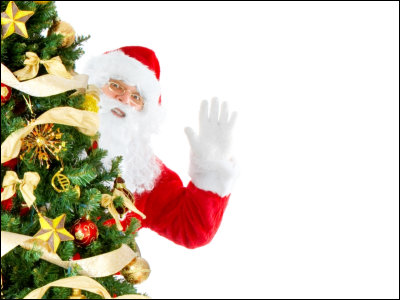Learning from the famous "TED" for a great lecture Statistically the condition of the highest & lowest presentation
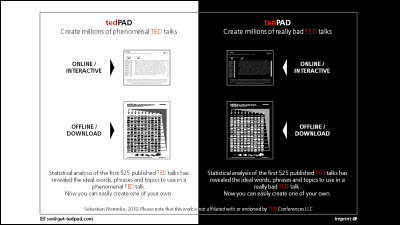
"Ideas worth spreading" mainly deals with three genres of technology, entertainment and design "TED"Has released numerous speech and presentation movies on Japanese website with Japanese subtitles on official website. From a very interesting thing to a non-interesting one, the abilities of the speakers are diverse, but we analyzed a number of presentations from the statistical approach and gave the best historical presentation at TED and the lowest presentation conditions for history A tremendous lecture to present is pretty good.
Lies, damned lies and statistics (about TEDTalks) | Video on TED.com
http://www.ted.com/talks/lang/jpn/lies_damned_lies_and_statistics_about_tedtalks.html
If you go to the TED homepage now, there is a video that goes over a week, and you can see the data of 1,300,000 words of transcription and the user rating of millions. It is really a huge amount of data. I saw it and thought like this. "If you apply all of this data to statistical analysis, you may be able to reverse engineer TEDTalk to make the ultimate TEDTalk, and also the lowest TEDTalk that you can tolerate."

I focused on three points to confirm this. "Subjects to choose" · "How to present lectures" · "Look on the stage".
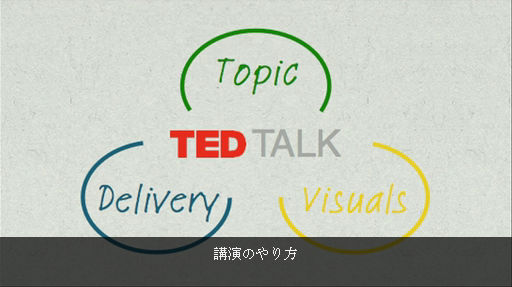
Well, although the subjects that can be selected vary widely, you must choose wisely. The material is closely related to the reaction of the user.
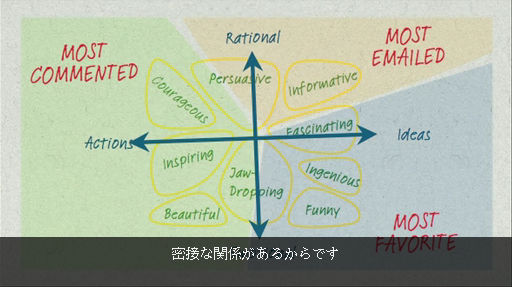
In order to make the story more concrete, I picked up ten words that are commonly found in the most favorable Talk and least preferred Talk from a statistical point of view.

In TED, if you talk about "happiness" that "French" "coffee" brings to "your" "brain" it is no mistake of success.

On the other hand, if I'm planning to talk about projects involving 'oxygen', 'girls' and 'planes', I personally would like to ask, but it does not work statistically.

And if this is more generalized, the most preferred TEDTalk is topics such as "happiness" "body" "food" "feelings" that we can easily relate to ourselves.

More topical topics "architecture" "material", and also interestingly "man" something is not good at TED.

Next is how to make a lecture, but it is well known that TED's noisy time. So, if you teach this thing you will get a bad face, please speak as long as possible. The most preferred Talk is more than 50% longer on average than unwanted Talk.

This also applies to individual ranking lists, but with exceptions, let's keep talking briefly if you want to be "beautiful", "exciting", "funny", or else until you are dragged down.

Then, there are rules to protect on lecturing. I found this rule by taking the statistics of the four word phrases that appear in each of Talk which is liked and Talk which is not liked. I will give you three examples. First of all, as a lecturer, I should tell the audience "I can offer it to myself" and not say "I can not do it".

Secondly please avoid quoting "New York Times" absolutely.

Finally ... ... Although this is a good news ... ... It is OK that the speaker knows about it. When you do not understand, just say "ethosetra et cetera". Everyone comes with us so there is no problem at all.

Next is a story of appearance. The first thing on the stage is the speaker himself. In order to join the most favorite lecturers as a result of analysis, please stretch the hair a little longer than the average, do not forget to wear glasses and make a dress better than the average speaker.

Let's use props as well as props. And it is the atmosphere of the stage that is very important. Color plays a very important role.

The evaluation of the lecture on the website is closely related to the color.

For example, an "attractive" lecture contains a lot of purple compared to the statistically average lecture.


"Creative" lecture has lots of green ...... Etcetra et cetera. I guess it is not my first time to do such an analysis. But let's leave this to your judgment.

Let's make all these together to make the ultimate TEDTalk. This is TED Active, so you should do something that you learned from the analysis. I do not think I will push the ultimate Talk or the worst Talk. We prepared tools that you can make your own.

It is TED Pad. Using this TED Pad, you can combine specially selected 100 sentences and create your own TEDTalk. The thing to make a decision is to talk about "creativity" or "wisdom of mankind" with a white version for Talk only, or make it a black version and make a very bad TEDTalk, "blog" or " Politics "or something to talk about.

Please download and try. I hope you enjoyed this session. Please make your ultimate TEDTalk and the worst TEDTalk. And, someone inside you inspired and I am looking forward to hearing such a lecture at next year's TED. thank you for your attention.

In addition, "TEDPad" that came out during this presentation is real, there are versions that can be used online, and versions that can be downloaded and printed, respectively.
TedPAD - create millions of amazing and really bad TED talks
http://get-tedpad.com/

Although the Japanese translation of this presentation title is "a story about a red lie and statistics about TEDTalks", you can get out of the worst presentation and make the best presentation .... should be ... .... Probably, probably.
Related Posts:

